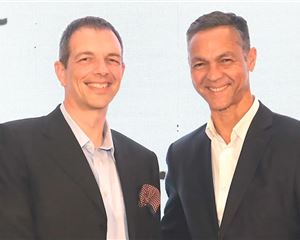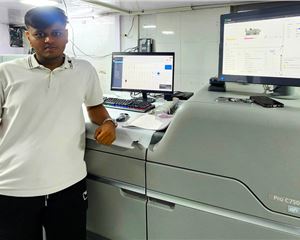In the past six months, 3M has seen the integration of its three major businesses. 3M Commercial Graphics got integrated with two other businesses – Building and
Commercial Solutions and Architecture Markets. Ramu Ramanathan talks to the general manager of the new business entity, Commercial Solutions Division, Dr Sujatha Narayan, to understand her new role in the business and 3M’s green offerings to the world.
Narayan is an unusual person at the helm, with a PhD in Polymer Science and Engineering from Georgia Tech, Atlanta, US. She graduated from IIT Delhi with a BTech in Textile Technology and Fiber Science and hails from Chennai. Narayan has been associated with 3M previously, in the 3M India Healthcare business laboratory as the R&D manager. Before 3M, she worked at Rogers Corporation in the USA in various roles, related to new product development and R&D project management.
Ramu Ramanathan: Commercial Solutions Division (CSD) is a new business of 3M India. So what is happening at the new 3M in India?
Sujatha Narayan (SN): It is an integration of the Commercial Graphics, Building and Commercial Solutions and Architectural Markets divisions. The new CSD business aims to enable our customers to effectively use their premise space for branding that is intended for their customers as well as employees.
RR: What is the objective?
SN: The objective is to take any premise or building and help our customers either brand to their external clients through our signage, graphics or architectural solutions or brand to their internal customers, who are their employees, with graphics, architectural, cleaning and safety product. This help our customers directly drive revenue in the former case and/or retain their talent in the latter.
RR: This is where 3M products come in?
SN: Yes. For example, a major Indian IT company with campuses all across the country has tonnes of printed internal graphics which has been customised for them. There are other architectural materials like glass films (frosted films, printed film for glass, optically clear printable film, etc) as well as architectural surface cladding films, which can substitute any material in look and feel but are basically films which can be applied very easily. We also have white board films which are used in a lot of refurbishments of writing surfaces. This comprises the architectural part. Maintenance of these beautiful modernist spaces constitutes the second part of our business. We have a lot of solutions to keep your premises clean. Matting solutions to trap dirt from your feet keep the space clean and floor shiny. Floor pads for floor cleaning at the airport are also a good example to showcase our portfolio. We offer cleaning solutions and tools, and a whole range of products to keep the premise clean. Instead of operating through multiple businesses reaching out to the same customer, we consolidated all into one business unit.
RR: So, the aim is to provide comprehensive offerings which none of your competitors have – in the graphic space, cleaning space or architectural space?
SN: When I took over in August 2014, the commercial graphics team would contact the brand owners, a second team would focus on the IT companies for the architectural branding. I revamped this business model. Today, everyone reaches everyone and pitch to sell the entire commercial solutions portfolio. It brings value to our customers.
RR: Rs 47-cr net profit for 3M India in total. What is the CSD share?
SN: We don’t breakdown our sales at division level. We are part of the safety and graphics business which is the second largest business in 3M India.
RR: In that case why has 3M not established manufacturing in the graphics part of the business in India?
SN: A major share of our portfolio comprises of self adhesive films. The adhesive coating process is cost effective only with large volumes. Also, the best way to achieve a good yield is to coat a large volume at one time. So far we have been consolidating manufacturing only in hubs. Localisation will be highly relevant to the printing part of the business. We have the coloured vinyl part which may never be brought in due to large variety in colours. And so, to reinstate, consolidated global volumes is the most effective way to do that.
RR: This means you source from plants in China, Korea, etc?
SN: The products in India are coming from all over the world. We source from the US, Korea, China and Japan.
RR: Have you been affected by the low pricing strategy of some your competitors?
SN: No. If you look at the pyramid structure, 3M caters to the players in the A and B levels and sometimes at C, only for strategic reasons. The Chinese products, which you speak of, are used in the C and C(-) range. Our strategy is not to enter in these territories. At times we look at digital printers whom we are not tapping, and then plan to enter with a price sensitive strategy.
RR: Does this spell bad news for solvent printing?
SN: Not really. Our substrates for promotional category which is entering the tier-C space are solvent printed. To qualify a material, we go through all the quality audits for solvent, eco-solvent, latex and UV to avoid printers from using a platform that is not recommended. In fact the lowest flexible substrate at 3M is printed on solvent. We understand that the solvent market exists in India, and we come to terms with it.
RR: OOH was generating Rs 2000-crore two years ago. Today, it is Rs 3200-crore. In this sense what is 3M’s plan for this sector?
SN: We don’t play in OOH at all. Our core tech is pressure sensitive adhesive and films. OOH is mostly about hoardings but we focus only on the digital part of it. Nothing is in print.
RR: What about visual merchandising at airports and metros which are part of OOH?
SN: The city Metros are looking at signages on stations. Plus they are wrapping the trains with ads. At 3M we are working very close with them. When we sell a product for railway train wrapping, we have strong value proposition. We have got the durability, fire retardancy, colour fastness, conformability, changeability and other such features that are required especially in trains for safety reasons.
RR: So 3M works with railway authorities on these projects?
SN: Our marketing, sales and R&D team work directly with the authorities. Based on the requirement, they get 3M products specified. After finalising the specification, the tender goes out to media companies who use our product. This is where 3M plays a major role. We connect the media to the right PSP. For instance, we have got PSPs who have digital match component system warranty. We play the role in the entire product chain with end customers specifying our products, with the media companies to help them understand other important factors in train wrap which goes beyond price. Plus we help the printer to fabricate the job.
RR: What sort of warranty are we talking about?
SN: The globally approved printing companies require weathering and ink adhesion tests. The media travels in different environmental conditions. It is stored in ambient temperature, printed in air conditioned rooms and finally mounted in the harsh sun or torrential rain. All this need some kind of acclimatisation. Otherwise there can be errors in printing, ink defects, etc. This will affect the market image and position of the Metro project in the market. Therefore we invest a lot of our real-time in training, especially on the application front.
RR: So, when 3M talks about warranty it’s actually about the applied product. Right?
SN: Yes. It’s very essential that we have high engagement with our PSPs and converters. It boosts confidence in them that they can do the job. Ultimately, its the quality of 3M which is reflected on the signages, and is visible to the public.
RR: There seems to be a lot of emphasis at the destination point. What is happening at the PSP workshop where the PSP is putting text and graphics on material? What is the nature of 3M’s engagement with PSP?
SN: It starts with profiling the printing machines and hardware to our media. Later we train them with the basics of technology, loading of the media and others important subjects. Finally comes the installation part. Then the team decides whether the printer can be engaged for execution.
RR: So this includes application training and upgrading your partners across the industry?
SN: Yes. India’s talent pool lacks the skills or the ability to apply graphics in the correct way. At 3M, we help briefing the PSPs about the nature of application and the right way of doing it. The training is given to the sales force or marketing personnel so that they are aware of the solutions they can offer to the clients. The application part of the training is for installers to teach film installation on various surfaces including trailers, vehicles, rough or smooth walls, interiors, etc.
RR: In a Metro project, what does 3M insist on?
SN: On the metro, the authorities are very particular about the safety of the coaches. Once the film is pulled off, it shouldn’t damage the coach. 3M provides this guarantee through a removable changeable adhesive. Additionally, while deploying flash cuttings, the cutters shouldn’t damage the coach. We also have stain resistant films, which can be easily cleaned. These are specially designed for metros, locals and platforms. At 3M, the application part is important for product development.
RR: What about cut vinyl solutions?
SN: Our cut vinyl solutions are used mostly in illuminated sign boxes. We give warranty on finished boxes. So even though it is the converter who is fabricating the box using our vinyl, we have authorised converters who are audited and have agreements on the finished product.
RR: So 3M is making a conscious effort to position itself as a solution provider and not merely as a raw material supplier. The moot question is, has your mindset benefitted the market?
SN: Of course, yes. Another thing we have done in the past four years is, offer turnkey solution for graphics customers who have a wide network in terms of locations like banks or retail outlets. This allows the customer to deal with one quality driven and reliable organisation for the implementation of the entire project across the country in a timely way that can retain and project their brand identity.
RR: What is happening on the partnership with the HPs, EFIs and Oce?
SN: Globally we have tie-ups with HP, EFI, Oce, Roland, Mimaki and others. From the point of view of a comprehensive warranty, 3M is working on ink formulations also with these companies at a global level. In India, it is the HP which is predominantly present, which is why, we prefer a Latex platform. There are not many PSPs with EFI platforms, so we become limited with the execution capabilities.
RR: For instance, there are eight Acuity Advances from Fuji in India. What is your approach? The PSPs who use Acuity produce tiles, ceramics and in addition they would use 3M products. How do you outreach with these customers?
SN: Typically, we depend on global customers. This is because a lot of our warranties have to be authorised globally. Many local customers have approached us, but we have not been able to serve them because our process runs globally. However you are right, we should interact more with local players in terms of their activities in India.
RR: How big is 3M’s PSP base?
SN: It would be 900 PSPs. We have engagement with 400 PSPs. This year we plan to engage with 1000 PSPs. We see it as an opportunity as we cannot talk to all brands personally. PSPs make great partners in engaging customers who are working on their branding projects.
RR: Do you connect these PSPs to the 50 super brands or the focus is on material sales?
SN: We engage with major brands ourselves as well as through our PSPs and sign box converters.
RR: Going forward, what is 3M’s green emphasis?
SN: Stepping ahead, it is all about green. Our first green step is the launch of Envision in India. From an energy efficient perspective, we are promoting the move from CFLs and tubelights to LEDs. We have films that will enable these bright LEDs for illuminated signage, for both coloured graphic material and flex. Third, we have cost competitive green solutions for hoardings and self adhesive films from India point of view.
RR: What would be the extra cost a customer has to pay for going green?
SN: Close to 25%
RR: Where do you see print in a few years time?
SN: We expect 16% growth in the next five years. That’s why we have designated a team specifically for PSPs. We will never compromise on quality. Furthermore, on environmental issues, we won’t play the price game. We shall invest a lot in R&D and continue to be profitable. We intend to provide solution to brands and do that in a manner where experience of both the brand and the channel is positive. Our aim is to have timely stock, quality product adhering to the warrantees and be as price competitive as possible.
RR: What’s happening at the science front at 3M?
SN: Green solution and environmental sustainability is the key. Our whole focus is on PVC free products plus developing graphics for new applications. This means cars, trains, plane wrapping, etc. We have a film which can reduce the LED cost in a sign. These are coloured electrocut films applied on a flexible substrate. It’s a breakthrough technology.
RR: Your favourite 3M product?
SN: It has to be from the healthcare division where I was heading the R&D team for five years. Here, we moved from export to a local model. In skin prepping for patients before surgery for skin antisepsis, alcohol or iodine is used. We did a combination of alcohol and CHG (Chloro Hexane Glutenate). Alcohol acts as a disinfectant while CHG continues the disinfection throughout the surgery. We were the first to launch this in India. We also designed surgical drapes which are absorbent on one side and impermeable on the other. It was for the first time in India that the surgical drape packs were available which were specific to the surgery. This helped medical teams adhere to the global guidelines and laws to keep the operating theatre aseptic and be convenient.
RR: And finally 3M is seen as a green champion! Your comment.
SN: Even if India is behind the developed world in terms of adapting and insisting on environmentally sustainable technologies, it is important for innovative companies like 3M to bring about the change in an affordable manner. So, we are spending a lot of effort even in local R&D to develop sustainable solutions that are more energy efficient and not adversely impactful on the environment.
5 TOP PRODUCTS

3M Scotchcal Clear View Graphic Film 8150
Highly transparent and conformable cast PVC film
PET backing to prevent static charge or discharge during processing
For window advertising, glass and vehicle graphics
Optimised for wet application
Scotchgard Graphic and Surface Protection Film 8991
Tough, gloss polyester 100-micron film
Provide graffiti and scratch resistance For smooth surfaces
Resist the harsh chemicals needed to remove paint, felt tip pen, etc
Can be easily rubbed by cloth or dusters
Other grades in the range: 8993 and 8995 have thicknesses as low as 25 and 23-microns respectively
3M Envision Print wrap film 480Cv3
Non-PVC 2mil thickness giving performance with sustainability
Can stretch up to 150% and doesn’t lift
Compatible for inkjet and screen printing
A versatile and conformable product – wraps everything from car bumpers to boats to textured buildings
3M™ Scotchcal™ Luster Overlaminate 8524
Compatible to solvent inkjet printing
For textured surfaces
Fast, clean and generally more cost effective compared to painted graphics
Used during the Commonwealth Games in Delhi
Controltac Graphic Film IJ-180C
2-mil white, vinyl film with a luster finish
For solvent, UV and latex inkjet printing
Flexible; conforms to compound curves, corrugations and rivets
Used as laptop skins, wraps on vehicles and walls without any residue or stains
|
FUN TRIVIA - Sujatha Narayan |
|
What are you reading?
I have little time to read these days, but I am essentially a fiction reader and have gobbled the Harry Potter series and that’s my favourite series of books even now.
In leadership books, I’m a big fan of Steve Covey.
More recently, I have migrated to Indian authors like Ashok Banker (Prince of Ayodhya) and other Indian mythology books like Shiva Trilogy, the Ramayana series, etc.
|

















 See All
See All